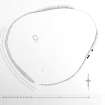Pricing Change
New pricing for orders of material from this site will come into place shortly. Charges for supply of digital images, digitisation on demand, prints and licensing will be altered.
Bargain Hill
Earthwork (Prehistoric)
Site Name Bargain Hill
Classification Earthwork (Prehistoric)
Canmore ID 61951
Site Number NX18NE 4
NGR NX 19142 88431
Datum OSGB36 - NGR
Permalink http://canmore.org.uk/site/61951
- Council South Ayrshire
- Parish Colmonell
- Former Region Strathclyde
- Former District Kyle And Carrick
- Former County Ayrshire
NX18NE 4 1913 8843.
NX 1913 8843. There are vestigial remains of a pear-shaped fort, measuring 552ft ENE-WSW by 305ft defended by a double rampart with medial ditch, on the summit of Bargain Hill (visible on APs RAF/106G/UK172: 3155-6).
The inner rampart is still traceable on the WSW side in the form of a grassy bank 3.0m to 4.5m thick and 0.6m maximum height, but on the north and SE sides it is represented by only a low scarp while the ENE end has been entirely obliterated. Three boulders embedded in the base of the scarp on the SE side suggest that the rampart may have had an external kerb or revetting wall of stone, but no stonework is visible at any other point in the circuit. Faint indications of the ditch and outer rampart, too indefinite for accurate measurement, can be seen on the WSW side. APs show both elements on the SE side also, so that it can be assumed that they were originally continuous. A gap in the south arc of the inner rampart, 4.5m in width, presumably represents an original entrance, and it is possible that there was a second entrance at the ENE end.
Apart from a water-holding hollow, which may be artificial the interior is featureless (RCAHMS TS, 1 September 1954).
Visited by OS (JD) 12 October 1955
No change to report of OS (JD).
Surveyed at 1:10 000.
Visited by OS (BS) 14 January 1976
The remains of this fort occupy the undulating and outcropping summit area of Bargain Hill at some 215m OD. Given that the N and NE sides of the fort were complete but have not survived, the minimum overall dimensions would be some 180m NE-SW by 110 transversely. The suggested outer rampart, visible only around the SW, appears to be no more than a low, upcast bank (0.3m high) from a shallow 2m to 3m wide medial ditch, possibly indicating that the present slight defences form just one phase of an unfinished work; there is little natural defence on the W and SW sides.
Visited by OS (JRL) 4 December 1980
(NX 1913 8843) Fort (NR) (remains of)
OS 1:10000 map (1979)
Field Visit (1 September 1954)
This site was included within the RCAHMS Marginal Land Survey (1950-1962), an unpublished rescue project. Site descriptions, organised by county, are available to view online - see the searchable PDF in 'Digital Items'. These vary from short notes, to lengthy and full descriptions. Contemporary plane-table surveys and inked drawings, where available, can be viewed online in most cases - see 'Digital Images'. The original typecripts, notebooks and drawings can also be viewed in the RCAHMS search room.
Information from RCAHMS (GFG) 19 July 2013.
Reference (1957)
This site is noted in the ‘List of monuments discovered during the survey of marginal land (1951-5)’ (RCAHMS 1957, xiv-xviii).
Information from RCAHMS (GFG), 24 October 2012.
Field Visit (July 1981)
Bargain Hill NX 191 884 NX18NE 4
This earthwork, situated on the summit of Bargain Hill, probably measured about 90m by 78m internally. It is protected on the SW by a bank (3m thick by 0.3m high) with an external ditch (2.8m broad) and a low counterscarp bank, but on the SE and W only the bank survives (as a scarp about 0.6m high), and there are no visible traces of any defences on the NW and NE. The entrance may have been on the SSW.
RCAHMS 1981, visited July 1981
Watching Brief (August 2006 - September 2008)
A Cultural Heritage Assessment was undertaken by CFA Archaeology to assess the potential impacts from the construction and operation of the proposed wind farm on Breaker Hill. The assessment included a desk-based study and a reconnaissance field survey of the area.
CFA Archaeology Ltd (G. Mudie) 2008
Note (20 December 2013 - 23 May 2016)
This hilltop enclosure, which takes in the whole summit of Bargain Hill, has a relatively slight perimeter, where best preserved around the SW quarter comprising no more than a low bank 3m thick by 0.3m high, fronted by an external ditch about 2.8m broad and traces of a low counterscarp bank. On the WNW and SE only the line of the bank can be traced, forming a scarp about 0.6m high, and even this disappears around the NE quarter. Three boulders are set at the foot of the scarp on the ESE, but if these belong to a face or revetment there is no trace of such a feature elsewhere. The entrance may have been on the SSW. The interior, which measures about 90m from NE to SW by 78m transversely (0.5ha) is featureless, though in 1954 K Steer suggested a small water-filled hollow might be artificial.
Information from An Atlas of Hillforts of Great Britain and Ireland – 23 May 2016. Atlas of Hillforts SC0208




























